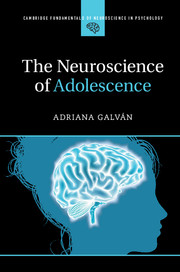Book contents
- The Neuroscience of Adolescence
- Cambridge Fundamentals of Neuroscience in Psychology
- The Neuroscience of Adolescence
- Copyright page
- Dedication
- Contents
- Figures
- Preface
- Chapter One What Is Adolescence?
- Chapter Two Puberty
- Chapter Three Cognitive Neuroscience Methods to Study the Adolescent Brain
- Chapter Four Brain Plasticity
- Chapter Five Neurocognitive Development
- Chapter Six Motivational Systems
- Chapter Seven The Social Brain
- Chapter Eight The Implications of Adolescent Neuroscience on Policy
- Glossary of Key Terms
- Complete List of References
- Index
- References
Complete List of References
Published online by Cambridge University Press: 15 September 2018
- The Neuroscience of Adolescence
- Cambridge Fundamentals of Neuroscience in Psychology
- The Neuroscience of Adolescence
- Copyright page
- Dedication
- Contents
- Figures
- Preface
- Chapter One What Is Adolescence?
- Chapter Two Puberty
- Chapter Three Cognitive Neuroscience Methods to Study the Adolescent Brain
- Chapter Four Brain Plasticity
- Chapter Five Neurocognitive Development
- Chapter Six Motivational Systems
- Chapter Seven The Social Brain
- Chapter Eight The Implications of Adolescent Neuroscience on Policy
- Glossary of Key Terms
- Complete List of References
- Index
- References
- Type
- Chapter
- Information
- The Neuroscience of Adolescence , pp. 256 - 306Publisher: Cambridge University PressPrint publication year: 2017

